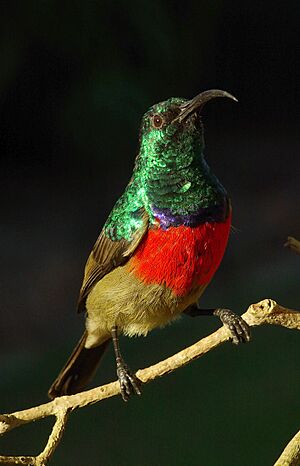Greater double-collared sunbird facts for kids
Quick facts for kids Greater double-collared sunbird |
|
|---|---|
 |
|
| Male at Greyton, Western Cape | |
| Conservation status | |
| Scientific classification | |
| Genus: |
Cinnyris
|
| Species: |
afer
|
 |
|
| range strongholds, occurring year-round lower density, passage or vagrancy |
|
| Synonyms | |
|
|
The greater double-collared sunbird (scientific name: Cinnyris afer) is a small, colorful bird. It belongs to the sunbird family, known for their bright feathers and long, curved beaks. These birds are often compared to hummingbirds because they also feed on nectar.
Contents
Where Does This Sunbird Live?
This sunbird makes its home in southern South Africa. Most of these birds stay in one place all year. However, some from the northeast part of their range might travel short distances, like going on a mini-vacation, to find food or better weather. You can often spot them in gardens, along the edges of forests, in coastal bushes, and in a special type of plant area called fynbos.
What Does the Greater Double-Collared Sunbird Look Like?
This sunbird is about 14 centimeters (about 5.5 inches) long. The males and females look quite different, which is called sexual dimorphism.
The adult male is very striking!
- Its head, throat, upper chest, and back are a shiny, metallic green.
- It has a wide, bright red band across its chest.
- Just above the red band, there's a thin, metallic blue stripe.
- The rest of its belly is a pale grey color.
- When a male wants to show off, you might see bright yellow feathers pop out near its shoulders.
The female sunbird is much plainer.
- Her feathers are mostly pale grey.
- Her wings are a bit darker.
Both males and females have a long, curved beak, which is perfect for reaching nectar deep inside flowers. Their beaks, legs, and feet are black, and their eyes are dark brown.
You can tell the greater double-collared sunbird apart from the similar lesser double-collared sunbird because the greater one is bigger. It also has a wider red chest band and a longer beak.
Sunbird Sounds: Calls and Songs
The greater double-collared sunbird has a distinct call that sounds like a sharp "chut-chut-chut." When it sings, it makes a high-pitched mix of tweets and twitters. This song is richer and more complex than the calls of its smaller cousin, the lesser double-collared sunbird.
How Do These Sunbirds Behave?
You'll usually see these sunbirds alone or in pairs. They are very fast flyers, moving quickly and directly on their short wings.
Reproduction and Nesting
These sunbirds can breed all year round, but they are most active from July to November. The female builds a neat, oval-shaped nest.
- She uses grass, lichen, and other plant bits.
- She holds it all together with spider webs, making it strong.
- The nest has a side entrance, sometimes with a small "porch" at the opening.
- Inside, the nest is lined with soft feathers to keep the young birds cozy.
What Do Sunbirds Eat?
The main food for the greater double-collared sunbird is nectar from flowers. But they also eat some fruit. When they have young birds to feed, they will also catch insects and spiders. They are quite clever! They can hover in front of spider webs to pull out spiders. While they can hover like a hummingbird to drink nectar, they usually prefer to perch on a flower or branch while they eat.



